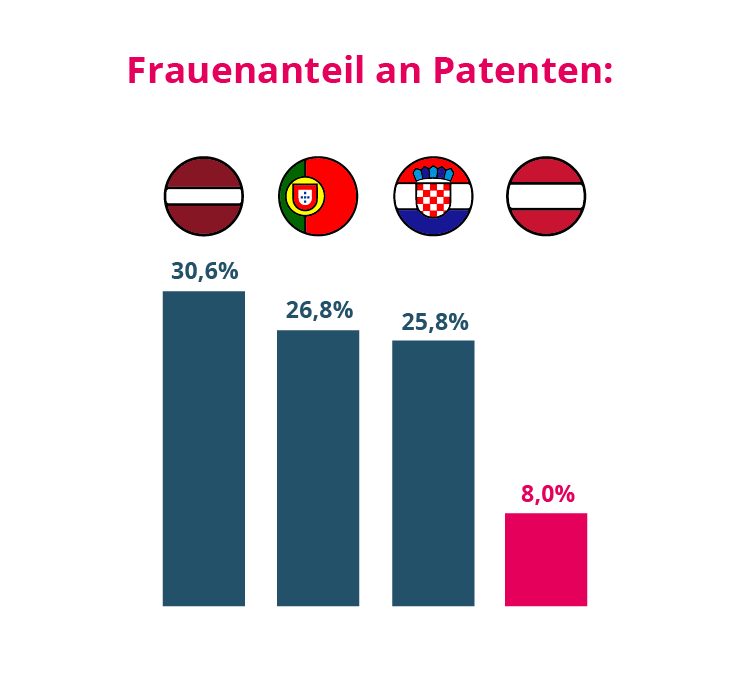Main content:
Woman and patents: Austria brings up the rear in Europe
Findings from the study of the European Patent Office "Women's participation in inventive activity". European and global comparisons.
8 Facts
- Austria brings up the rear in Europe: only 8% share of women in patenting.
- Liechtenstein with 9.6% and Germany with 10.0% just ahead of Austria.
- Ranking leaders in Europe: Latvia (30.6%), Portugal (26.8%) and Croatia (25.8%).
- Share of women varies by industry: In chemistry, the share of women in patents in Austria is 17.4% - below the average (22.4%).
- Whether typical male industries, in which Austria patents a lot (mechanical engineering, electrical engineering) or industries with higher female participation (biotech, pharmaceuticals): Austria is below average in female patents everywhere.
- Share of women varies strongly by region. Vienna metropolitan area: 14.8%, Salzburg 3.6%.
- Women as team players: women often patent in large teams, but rarely take leading roles and are therefore less often mentioned in patents.
- Female researchers at European universities patent 40% less than their male counterparts, despite equal productivity in research.
Austria brings up the rear in Europe
All countries that belong to the European Patent Convention were analyzed. These are currently 38 countries, namely all 28 EU member states and ten other non-EU countries, including Switzerland, Norway, Iceland and Turkey. Further comparisons were made with the largest patent countries in the world - China, Japan, Korea and the USA. The period observed was 1990 to 2019, with Austria in last place in the ranking, behind Germany and Liechtenstein. The proportion of women is also unchanged low over the entire period. Patent Office President Mariana Karepova: "Austria emerged from the European Innovation Scoreboard as number 1 in patenting. Everyone patents here, except women. Unfortunately, I am not surprised by this, we also know this from our national patent applications at the Austrian Patent Office, where the share is even only 6%."
Ranking leaders in Europe and beyond
It' interesting to note that a lot of patenting does not mean that the share of women in patents is also higher: Austria (8.0%), Germany (10.0%) and the Netherlands (11.9%), which are among the top 10 patenting countries at the European Patent Office, are at the bottom of the ranking. Other heavily patenting countries fare much better, with women accounting for 16.6% of patents in France, Belgium (15.8%) and Italy (14.3%). In Korea, the share of women in patents is 28.3%, in China 26.8% and in the USA 15%.
Share of women varies by industrial sector
At 22.4%, the highest and fastest-growing share of women among the 38 countries surveyed is in the chemical sector - here, especially in biotechnology, pharmaceuticals, food and organic chemistry. Austria has a female share of 17.4% in this sector.
In the technology fields of mechanical and electrical engineering, which are dominant in Austria, the proportion of female inventors is also far below the European average, at 3.1% and 3.5% respectively.
Mariana Karepova comments: "For a long time, we were able to make excuses about the industry structure, which is unfavorable for women. Most patents in Austria come from mechanical engineering and co, i.e. from industries where few women research and develop. Now we know that Austria is underperforming in all industries. Even in chemistry, where women are traditionally strongly represented."
Share of women varies greatly by region
In general, there are higher proportions of women in the capital regions. However, none of the Austrian regions can be found in the European top 10. Among the top regions are: London, Copenhagen and Lazio (Rome). The female inventor rate in Vienna is 14.8%. These are followed by: Tyrol: 8.8%, Styria: 8.2%, Burgenland: 8.1%, Upper Austria: 6.3%, Lower Austria: 6.3%, Carinthia: 5.4%, Vorarlberg: 4.4% and in Salzburg: 3.6%.
Women as team players
A study commissioned by the Austrian Patent Office on national patent applications filed by women has already shown that although women often work in research teams, they are rarely in a central position and thus do not feature in patents. This finding has now been confirmed by the European Patent Office study. The finding is similar in all countries. Mariana Karepova: "A few years ago, we took a close look at 15 Austrian companies with strong patent positions. The conclusion: less than half of these companies name women as inventors in their patents. These companies file dozens of patents a year. But it's only a handful of women who are in the game."
Women researchers at universities
Women at universities patent 40% less than their male counterparts, for the same publication output. Even when research results published by women lead to patents, women are rarely named as inventors in these patents. The names of male authors, on the other hand, are more likely to be found in the associated patent. The reason: women have fewer connections to industry than men and are limited to more traditional academic career models.
We know enough to act
"If 50% of students are girls, but only 25% study STEM subjects, if only 40% of researchers at the university are women, but only 16% in the companies where most Austrian patents come from and in the end only 9% patents are from women - then there is an urgent need for action at every point in this chain. Universities alone, funding agencies alone, the patent office alone cannot get this system moving. We need a joint show of strength," says Karepova.
A few women have made it and have successfully exploited their innovations with patents together with universities and industry. They are the role models who can change long-outdated images in our heads. But role models alone are not enough.
"The whole environment in which patents are created needs to become more female. More female patent attorneys (currently there are only 7 women out of 79 listed patent attorneys), more female patent officers in companies and more female patent examiners in the patent office. Women attract more women," Karepova said.
At the same time, we need support for all those who want to do more family work. Balanced partnerships enable women's careers. After centuries, the reverse must now be true: Behind a successful woman is a strong partner. Company bosses must also accept that a man can leave work early to pick up the children, so that the pressure is not all on women. In the pandemic, this problem has become even worse, and so women's patents have also declined even further during this time.
Women in management positions are still the exception - especially in the technical field. Managers have it in their hands to make the exception the rule and put women in leadership positions. A first step in promoting women's careers is to know the high potentials in the company - including their strengths and weaknesses - and to train their skills. The IP Academy of the Patent Office will therefore offer special IP seminars for women starting next year, which will not only create awareness for intellectual property, but also provide a platform for networking among female researchers, inventors and entrepreneurs.
08. November 2022

